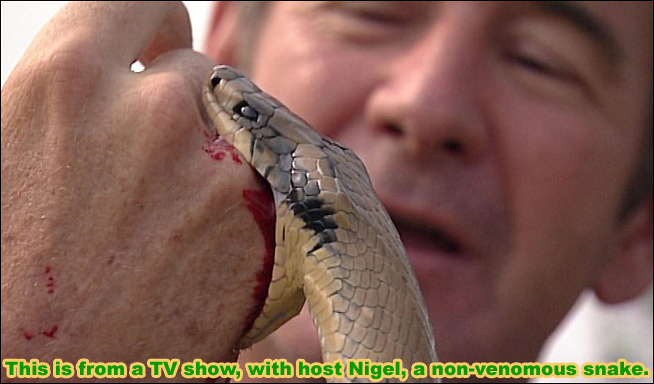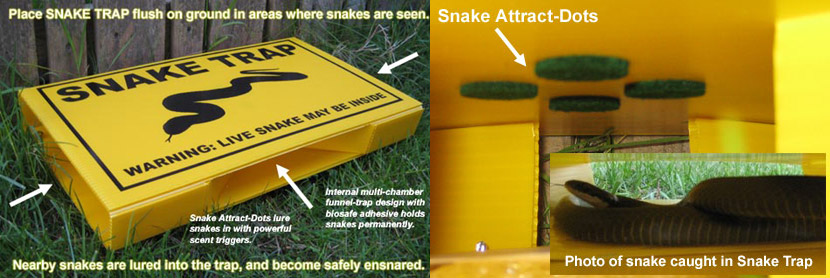Your best bet is to not get bitten in the first place! If you
see a snake, leave it alone. Almost all bites occur when people
try to catch, kill, or mess with snakes. Just walk the other
way. But, if it's too late...

There are two kinds of snake bites: venomous bites and
non-venomous bites. A venomous strike (if venom is actually
injected) going to hurt incredibly badly and both venomous and
non-venomous bites are going to bleed profusely. Both types of
bite can be serious, though only one is fatal. If you’re bitten
by a snake, medical attention should be sought as soon as
possible.
Venomous Snake Bites: The most common reason people get
bit by poisonous snakes is when people attempt to catch or kill
snakes! Most of the time, if you leave a snake alone, it'll
leave you alone, and no snake will every pursue a person to
strike for no reason. Some bites do occur by accident. Snakes
are often camouflaged in their natural environments, making it
easy for them to be overlooked and stepped on. A snake needs
only to feel threatened before it bites. This threat can be
initiated by being stepped on or simply by being too close to
the snake for its comfort. A snake bites a human out of fear,
not out of aggression. If you are bitten by a venomous snake,
time is of the utmost importance. The sooner you get to a
medical facility, the sooner you will prevent the toxin from
spreading through your system.
Non-Venomous Snake Bites: Non-venomous bites often occur
by accident, though most non-venomous snakes are shy and will
retreat from a person before biting. If the snake feels
antagonized, that is when it will most likely strike. Most
snakes have an anticoagulant in their saliva. This will keep the
wound open and bleeding, so applying pressure to the area is
important. Even small bites can be prone to infection and
complications, so it is important to seek medical assistance as
soon as possible.
What To Do For Any Snake Bite: If you are dealing with an
unidentified snake, there are a few tips that will help you
while you wait for medical assistance. First, do not move unless
it is necessary. Movement will increase heart rate, and an
increase in heart rate will increase circulation. If the snake
is venomous, an increase in circulation will spread the toxin
through your body faster. Do not lance the skin above or below
the bite. There is no scientific proof that bloodletting will
remove any poison. In reality, the toxin is usually well up the
limb by the time a knife is produced to slice the skin. Doing
this will only increase discomfort. Similarly, sucking on the
bite area will be ineffectual, placing you in harm’s way through
ingestion of poison. Another common but false tip is to apply a
tourniquet to the affect extremity. By cutting off the blood
flow, you risk losing the limb regardless, even when it may have
been saved with the administration of anti-venom. The bite
should always be washed immediately with soap and water to help
lessen the risk of secondary infection.
If medical care is over fifteen minutes away, it is recommended
that a bandage be placed over the bite, applying pressure but
not cutting off circulation. Snake bite kits will often have
suction devices to use on the wound. While using your mouth as a
suction device is not advised, the benefit to using a strong,
commercial, suction tool is acknowledged.
The easiest way to take care of a snake bite is to avoid getting
one in the first place. Knowing your local snakes and their
habitats is important, especially if you are interested in
hiking or other outdoor recreation. Wear appropriate clothing.
In snake country, tall boots are a necessity. Since snakes are
on the ground, the most susceptible bite point on a human is the
leg. Avoid reaching into brush, sticking your hands under logs,
or turning over rocks. Snakes like to live under objects. Poking
fingers into hidden areas can be hazardous. Be watchful and
wary. Most importantly, do not try to handle a snake if it can
be avoided. Reaching for snakes, trying to kill snakes, or
trying to remove snakes are all reasons people suffer from snake
bites. Avoidance is the key when it comes to these scaled
creatures. They are just as afraid of human-snake interactions
as we are. Snakes, however, will attack when threatened, and
that’s when the trouble begins.
Option 1 - HIRE A PROFESSIONAL
We can solve your snake problem for you. Our nationwide group of snake specialists services 95% of the US population. Click here to find your local snake removal expert in your town. Below are just some of our more popular areas:Option 2 - BUY A SNAKE TRAP
If a snake is indoors, a trap will work. I do not recommend using a glue-based trap outdoors, because it can inhumanely catch other small critters. I have reviewed and field tested several snake trap designs, and the one featured below is the most durable and effective. It is the highest quality snake trap available on the market. Read more about Snake Trap.
For more information, go to my Snake Removal - How to Get Rid of Snakes home page.
Read more snake topics:
How to lure a snake out of hiding or hole?
Understanding Snake Venom and How It Works
How do snakes eat?
Do snakes live in holes?